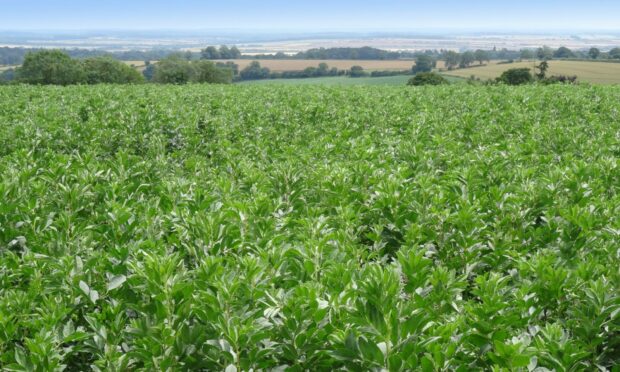Imagine if legumes were discovered today – a crop that can pull nitrogen out of the sky and place it into the soil for both the current and subsequent crop.
It would be hailed as one of the greatest discoveries for modern day farming, especially with nitrogen prices peaking at over £700/t this year.
However, legumes have been around for thousands of years and yet this “magical” crop has failed to cement itself as a mainstay on Scottish farms.
Haunted
Why? Farmers have long memories and will be haunted by images of bean harvests in December or meagre and inconsistent yields.
However, I believe things have changed, and it is time for legumes to shine in Scotland.
We have been growing a spring bean variety in the autumn here for five years now, and for three of them, beans have been the highest gross margin crop on farm.
Sowing the beans in late autumn has brought the harvest date forward several weeks to be in line with the wheat harvest. The wheat crop following beans is averaging an extra 0.5t/ha over any other preceding crop, due to the soil conditioning and N fixation from the beans.
Catch-22
The legume industry in Scotland is in a catch-22 position, no one wants to grow them due to a lack of funding for research, and as a result there is less levy produced for funding new varieties.
We can only hope the Scottish Government, when they do decide to progress with future agricultural policy, look more favourably upon legumes than they did last time round.
I was delighted to see legumes had appeared as an Ecological Focus Area (EFA) option, only to find you had to split the crop 70:30 within the field with another legume and have a margin around the entire perimeter of the field which couldn’t be cut until January.
Farce
The entire option was a farce and was unsurprisingly met with a low uptake of legumes.
A sensible government incentive could have created a flourishing bean market in Scotland. Legumes should tick a lot of government boxes; no synthetic nitrogen requirement, suited to direct drilling, offsetting imported soya.
All in all, a very environmentally friendly crop – our annual bean crop also supports a hive of 10,000 honeybees.
Even without government incentives, the future for beans in Scotland is bright.
Inputs
Modern varieties seem to thrive in Scottish conditions, they take very little input throughout the season, with my typical program being one herbicide, one fungicide, and some micronutrients.
A booming export market to Egypt and Sudan who crave Scottish beans free from bruchid beetle damage, a pest not yet prevalent in Scotland but a plague on our English counterparts.
Interest in beans and peas have peaked this year, as to be expected from any crop which doesn’t require nitrogen fertiliser at current eye watering prices.
Trials
We have sown several bean trials for Scottish Agronomy this year and will look at whether autumn sowing spring varieties will help to boost the protein content, making the beans more attractive to feed compounders versus imported soya.
Beans have been a huge part of our conversion to direct drilling over the last seven years and are now an integral part of our rotation. Our yields have averaged over 5t/ha for the last five years, however the bean Yield Enhancement Network (YEN) in which I participate has shown that yields of beans can be up to 10t/ha.
Premiums
With feed prices alone at £200t, and human consumption premiums on top of that it’s not hard to see why beans are my favourite crop!
We are just scratching the surface with legumes in Scotland and with a little input and research beans could well become Scotland’s favoured break crop.
Craig Peddie farms near Anstruther and won a YEN silver award for a 2021 crop of spring barley.










